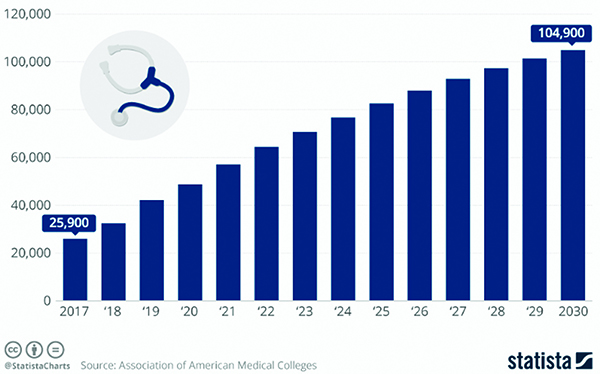Physician shortages are an increasing problem in the United States healthcare system. According to data from the Association of American Medical Colleges, the United States faces a projected physician shortage of up to 124,000 physicians by 2034, with demand for physicians outpacing supply.(1) Specifically, aging and population growth are major drivers of the increasing demand for physician services. Hospitals, clinics, and independent healthcare providers are feeling the pressures of this as the labor market is decreasing year over year. Figure 1 provides a great visualization of this issue.(2)

Figure 1. Projected supply gap in U.S. physicians from 2017 to 2030 (upper estimate).
Amid a physician shortage, telemedicine has played a significant role in providing access to care. The adoption of telemedicine accelerated rapidly in response to the COVID-19 pandemic, with lockdowns, social distancing measures, and the need to reduce in-person interactions necessitating healthcare providers and patients to turn to telemedicine as a safe and efficient alternative for non-emergency medical consultations. It has been an impactful aid during the most significant medical crisis of the 21st century.
Accurately predicting the use of telemedicine in the future will be challenging.
The Medical Group Management Association conducted a stat poll asking medical group leaders how they believe patient demand for telehealth will change in 2023. Forty-five percent of respondents expected no change in demand to occur, 28% expected a decrease, and 27% expected an increase in patient demand.(3) Accurately predicting the use of telemedicine in the future will be challenging due to the ever-changing legislation and regulations governing its use. Nevertheless, there is a strong need for these services.
Jesse M. Ehrenfeld, MD, MPH, President of the American Medical Association, stated that there is an urgent crisis hitting every corner of the country, with the most impacted individuals being families with high needs and limited means.(4) Telemedicine helps bridge the gap of access for individuals in rural areas to respond to their healthcare needs. The Health Resources and Services Administration published a report that analyzed the physician shortage in rural communities. The 2023 study showed that 65% of rural areas had a shortage of primary care physicians, with more than 15% of Americans living in rural areas. Additionally, the findings showed that only about 10% of doctors practice in these communities, many of whom practice primary care or family medicine.(5) Physician shortages are therefore directly impacting the most underserved healthcare population in America.
While the public health emergency (PHE) for COVID-19 ended May 11, 2023, section 4113 of The Consolidated Appropriations Act, 2023 extended many flexibilities. Two major topics of legislative extensions that will affect providers’ ability to partake in telemedicine are originating sites and distant sites. The originating site is the location where a patient obtains physician or practitioner medical services through telehealth. Through December 31, 2024, all patients can get telehealth wherever they are located. This means that they do not need to be at an originating site, and there are no geographical restrictions. Prior to the COVID-19 PHE, patients needed to receive telehealth at an originating site located in a certain geographical area.
In the face of persistent healthcare workforce shortages, telemedicine emerges as a transformative solution.
A distant site is a location where a physician or practitioner provides telehealth. Prior to the COVID-19 PHE, only certain types of distant site providers could provide and get paid for telehealth. The extensions provided in section 4113 of the Consolidated Appropriations Act, 2023 enable all providers who are eligible to bill Medicare for professional services to provide distant site telehealth.(6) Allowing all Medicare-eligible providers to continue providing telehealth services is an imperative starting point for expanding access to care.
In the face of persistent healthcare workforce shortages, telemedicine emerges as a transformative solution, reshaping the landscape of patient care. With continued support from government legislation, telemedicine can bridge the gap in patient care access. As we navigate a labor shortage, telemedicine provides an equitable future for providers and patients alike.
References
Heiser S. AAMC supports Resident Physician Shortage Ruction Act of 2023. American Association of Medical Colleges. https://www.aamc.org/news/press-releases/aamc-supports-resident-physician-shortage-reduction-act-2023 . Accessed November 17, 2023.
McCarthy N. American doctors: The prognosis isn’t good. Statista.com. https://www.statista.com/chart/8641/american-doctors_-the-prognosis-isnt-good/ . Accessed November 17, 2023.
Telehealth utilization and patient demand in 2023: best guesses and best practices. Medical Group Management Association. https://www.mgma.com/mgma-stats/telehealth-utilization-and-patient-demand-in-2023-best-guesses-and-best-practices . Accessed November 17, 2023.
Henry TA. The physician shortage crisis is here—and so are bipartisan fixes. American Medical Association. https://www.ama-assn.org/practice-management/sustainability/physician-shortage-crisis-here-and-so-are-bipartisan-fixes . Accessed November 17, 2023.
Empinado H. Treating rural America: the last doctor in town. STAT. https://www.statnews.com/2023/09/25/rural-health-doctor-shortage-physicians/ . Accessed November 17, 2023.
MLN Fact Sheet: Telehealth Services. Centers for Medicare & Medicaid Services. https://www.cms.gov/files/document/mln901705-telehealth-services.pdf . Accessed November 17, 2023.

